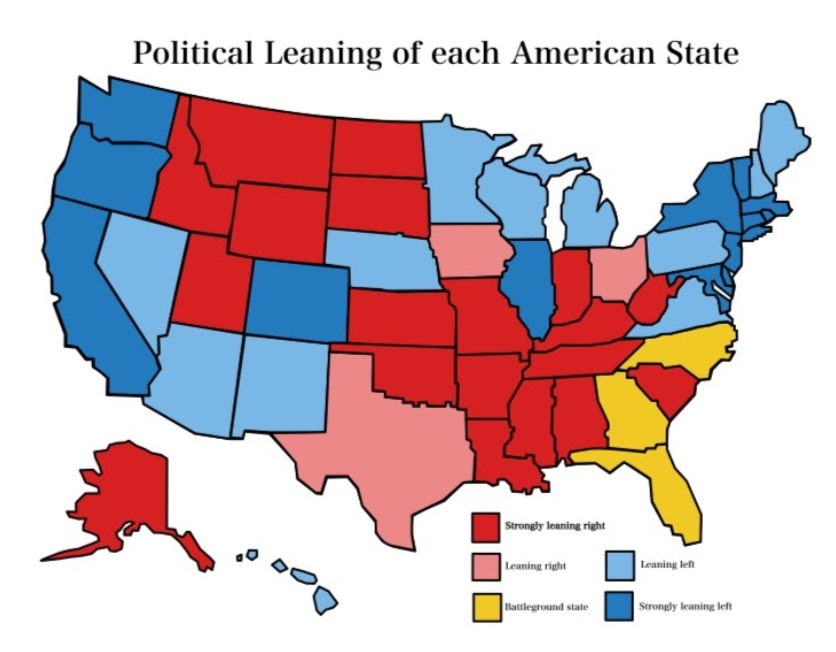This Presidential Election’s Battleground States
Many states may change their voting patterns this presidential election.
This November 3, voters will decide the future of America, and that future lies in the hands of Joe Biden or Donald Trump. With so much on the line in this Presidential election, many Americans are changing their political opinions, making this election an unusual one.
The adjusting opinions of American voters will create changes in each state’s role in this election compared to the 2016 election. Due to Trump’s performance during his current presidency and the United States’ current political climate, some voters are rethinking their opinions on Trump, leading to the swing of many conservative states.
Voters are left to consider their future concerning various topics such as the Covid-19 pandemic, healthcare, the economy, women’s rights, the LGBTQ+ community’s rights, racial equality, taxes, immigration, and climate change. Many of these issues are time-sensitive and must be addressed within the next four years by our President. This political climate is creating several battleground states and making formerly red or blue states become swing states.
In an article written for Brooking, Rob Griffin, William Frey, and Ruy Teixeira said, “shifting turnout and support rates can be pivotal for winning elections, these changes are likely to have a relatively small impact on the overall makeup of the electorate and party coalitions in the future. Thus, most of the effect of demographic change on future party coalitions is already baked in and will reshape party coalitions.”
The changes in state’s voting patterns will likely come from adjustments in demographics in certain states and cities. This is compared to a higher voter turnout, which will likely not happen due to America’s record of a low voter turnout. In fact, the fluctuation of particular cities and states will significantly affect battleground states.
Out of all of the states, Florida, Georgia and North Carolina are the primary battleground states each candidate has to work towards winning. Judging from the 2016 election margin, Florida leans slightly right. During this election, the Hispanic and Latino voters will be the main demographic candidates work to target for their vote in Florida.
Although Georgia has not historically been a swing state, it’s beginning to look like one during this election. Due to the growth of one of Georgia’s most prominent cities, Atlanta, Georgia’s demographic has grown more diverse, allowing for a change in voting patterns. In fact, during the 2016 election, Georgia voted for Trump, indicating it leans slightly right.
North Carolina, a historically known swing state, has had a change in its demographics over the past four years, making it likely they will vote differently than they did in 2016. In the 2016 election, North Carolina overwhelmingly voted for Trump; however, with the influx of professionals and college students over the past four years, rural and conservative voter voices may be drowned out in the upcoming election.
The states that are predicted to lean slightly left this year are Michigan, Minnesota, Nebraska, New Hampshire, Pennsylvania, Wisconsin, Nevada and Arizona. Combined, these eight states have a total of eighty-two electoral college votes, making it important for candidates to win these states over.
In an interview from NPR( National Public Radio), a voter in Wisconsin, Karen Cayman, told a reporter why she could no longer back Trump like she formerly did in the 2016 election. “He just wants people to riot. He instills riots and discord,” Cayman said.
After the many protests and riots that have taken place in 2020 calling for police reform and social justice, Trump has declared himself as the “Law and Order President,” a title that is appealing to some, but unnecessary to others. Cayman feels that the proper response to this situation would be to make the changes protesters are asking for instead of placing the police and military in positions to shut protests and riots down. She believes that the protests are creating more discord than anything else right now.
Iowa, Ohio, and Texas are leaning slightly right this election and combined, have a total of 62 electoral college votes. Since these are states that lean slightly left or slightly right, candidates have a better chance at making them change their voting patterns compared to states that vote staunchly left or right.
NPR also interviewed a voter in Minnesota named Gretchen, who told reporters why she will be voting for Trump this year, even though she voted for Hillary Clinton in 2016. “The Republican Party is kind of speaking to my heart more than the Democrats, so I think I’m going to have to vote [for] Trump this time” Gretchen said.
Over the past four years, there have been many alterations to this country that can cause a person such as Gretchen to have a differing opinion of Trump than they did back in 2016, however, this goes both ways. Considering the changes in demographics America has seen over the past four years, states will likely experience a fluctuation in voting patterns.
Due to various changes in this country over the past four years, this election will look very different than last. Since more and more Americans have discovered the day to day impact of politics on our lives, many have realized that in this election, we are voting for more than just a president, but rather our entire democracy. With so many issues in America being time-sensitive, Americans must consider that they are not just deciding the next four years, but they are making decisions that will affect them long into the future.





